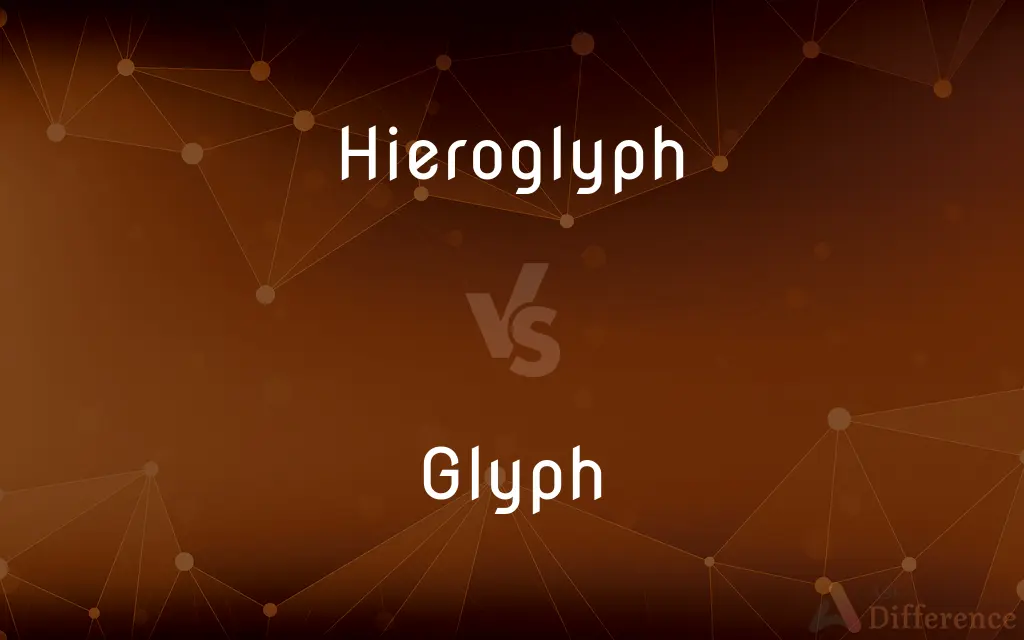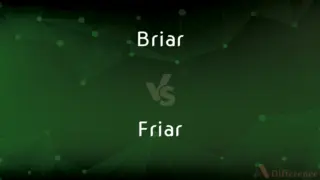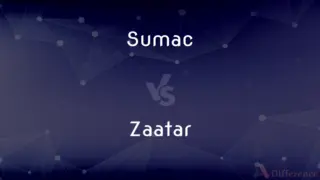Hieroglyph vs. Glyph — What's the Difference?
Edited by Tayyaba Rehman — By Urooj Arif — Updated on March 11, 2024
Hieroglyphs are ancient writing symbols used in systems like Egyptian hieroglyphics, while glyphs are characters or symbols in any writing system.

Difference Between Hieroglyph and Glyph
Table of Contents
ADVERTISEMENT
Key Differences
Hieroglyphs specifically refer to the pictorial characters used in ancient writing systems, such as Egyptian, Maya, and others. These symbols often represent objects, ideas, sounds, or a combination thereof, and were used for religious, ceremonial, and administrative purposes. Glyphs, on the other hand, are more broadly defined as any graphic symbols that provide the appearance or form for a character within a writing system, including letters, numbers, punctuation marks, and other symbols across various languages and scripts.
The term "hieroglyph" is often associated with ancient civilizations and carries a historical and cultural significance. Hieroglyphs are part of complex writing systems that require significant study to understand and interpret, reflecting the beliefs, practices, and daily life of the cultures that used them. Glyphs, however, are a fundamental component of written communication, present in both ancient scripts and modern fonts and typefaces. They are the visual representation of the elements of a language or system of notation.
Hieroglyphs were typically carved or painted on temple walls, monuments, and tombs, serving not only as a means of communication but also as art and historical record. They are characterized by their intricate designs and the use of symbols to represent sounds, concepts, or objects. Glyphs, while they can also be artistic, are primarily functional components of writing systems, designed to convey information efficiently in various mediums, from print to digital screens.
The study of hieroglyphs, such as Egyptian hieroglyphics, is a specialized field within archaeology and linguistics, requiring knowledge of the historical and cultural context to interpret the symbols correctly. The study of glyphs, however, is broader, encompassing typography, graphic design, and linguistics, focusing on the design, usage, and impact of symbols in communication.
Hieroglyphs are a subset of glyphs, representing a specific category of symbolic writing from ancient times. All hieroglyphs are glyphs, but not all glyphs are hieroglyphs. This distinction highlights the broader applicability of the term "glyph" in the context of written communication and the specialized nature of "hieroglyph" in referring to ancient symbolic writing systems.
ADVERTISEMENT
Comparison Chart
Definition
Pictorial character in ancient scripts
Any character in a writing system
Usage
Ancient writing systems (Egyptian, Maya)
All writing systems, modern fonts
Significance
Historical, cultural
Functional, linguistic
Representation
Objects, ideas, sounds
Letters, numbers, punctuation
Study Field
Archaeology, ancient linguistics
Typography, graphic design
Compare with Definitions
Hieroglyph
Hieroglyphs are symbols used in ancient writing systems, like Egyptian hieroglyphics.
The Rosetta Stone helped decode the Egyptian hieroglyphs.
Glyph
A glyph is any character or symbol in a writing system, including modern typefaces.
The ampersand (&) is a glyph representing the word and.
Hieroglyph
These symbols often represent objects or ideas, characterized by detailed pictorial representations.
An ankh hieroglyph represents life in Egyptian scripts.
Glyph
Glyphs are designed for readability and functionality in communication.
The legibility of a glyph is crucial in typeface design.
Hieroglyph
Traditionally, hieroglyphs were carved in stone or painted on surfaces, serving as both communication and art.
Hieroglyphs decorating tomb walls tell stories of pharaohs' deeds.
Glyph
The study of glyphs encompasses typography and graphic design, focusing on their visual form.
Typography experts analyze the aesthetic qualities of glyphs.
Hieroglyph
Hieroglyphs hold significant cultural and historical importance, reflecting the beliefs of ancient civilizations.
Maya hieroglyphs reveal much about their calendar and rituals.
Glyph
Glyphs are used across various languages and scripts, from alphabets to logograms.
Chinese characters are glyphs in a logographic system.
Hieroglyph
Hieroglyphic writing systems are complex, with symbols that can represent sounds, concepts, or both.
The Egyptian hieroglyphic system includes over 700 symbols.
Glyph
Glyphs appear in both digital displays and print, adaptable to different media.
Font designers create glyphs that are clear on screen and in print.
Hieroglyph
A hieroglyph (Greek for "sacred carvings") was a character of the ancient Egyptian writing system. Logographic scripts that are pictographic in form in a way reminiscent of ancient Egyptian are also sometimes called "hieroglyphs".
Glyph
In typography, a glyph is an elemental symbol within an agreed set of symbols, intended to represent a readable character for the purposes of writing. Glyphs are considered to be unique marks that collectively add up to the spelling of a word or contribute to a specific meaning of what is written, with that meaning dependent on cultural and social usage.
Hieroglyph
A stylized picture of an object representing a word, syllable, or sound, as found in ancient Egyptian and certain other writing systems
Hieroglyphs describing the Mayan calendar
Glyph
(Architecture)A vertical groove, especially in a Doric column or frieze.
Hieroglyph
A picture or symbol used in hieroglyphic writing.
Glyph
A symbolic figure that is usually engraved or incised.
Hieroglyph
Something that suggests a hieroglyph.
Glyph
A symbol, such as a stylized figure or arrow on a public sign, that imparts information nonverbally.
Hieroglyph
An element of an ideographic (hieroglyphic) writing system.
Glyph
A figure carved in relief or incised, especially representing a sound, word, or idea.
Hieroglyph
(informal) Any obscure or baffling symbol.
Glyph
Any of various figures used in Mayan writing.
Hieroglyph
To represent by hieroglyphs.
Glyph
Any non-verbal symbol that imparts information.
Hieroglyph
A sacred character; a character used in picture writing, as of the ancient Egyptians, Mexicans, etc. Specifically, in the plural, the picture writing of the ancient Egyptian priests. It is made up of three, or, as some say, four classes of characters: first, the hieroglyphic proper, or figurative, in which the representation of the object conveys the idea of the object itself; second, the ideographic, consisting of symbols representing ideas, not sounds, as an ostrich feather is a symbol of truth; third, the phonetic, consisting of symbols employed as syllables of a word, or as letters of the alphabet, having a certain sound, as a hawk represented the vowel a.
Glyph
A visual representation of a letter, character, or symbol, in a specific font and style.
Hieroglyph
Any character or figure which has, or is supposed to have, a hidden or mysterious significance; hence, any unintelligible or illegible character or mark.
Glyph
(architectural element) A vertical groove.
Hieroglyph
Writing that resembles hieroglyphics (usually by being illegible)
Glyph
A sunken channel or groove, usually vertical. See Triglyph.
Hieroglyph
A writing system using picture symbols; used in ancient Egypt
Glyph
A carved figure or character, incised or in relief; a carved pictograph; hence, a pictograph representing a form originally adopted for sculpture, whether carved or painted.
Glyph
Glyptic art in the form of a symbolic figure carved or incised in relief
Common Curiosities
What is a hieroglyph?
A hieroglyph is a symbol used in ancient pictorial writing systems, representing objects, ideas, or sounds, and is characteristic of civilizations like the Egyptians and Maya.
Where are hieroglyphs typically found?
Hieroglyphs are typically found in archaeological sites, carved or painted on ancient temples, tombs, and monuments.
Can a hieroglyph be considered a glyph?
Yes, all hieroglyphs are considered glyphs, as they are characters in a writing system, but not all glyphs are hieroglyphs due to the broader definition of glyphs.
What is a glyph?
A glyph is any graphic symbol that provides the form or appearance for a character in a writing system, including letters, numbers, punctuation, and other symbols.
How are glyphs used in modern writing?
Glyphs are used in all modern writing systems, appearing in digital and print media, and are integral to readability and communication design.
What fields study hieroglyphs and glyphs?
Hieroglyphs are studied in fields like archaeology and ancient linguistics, while glyphs are studied in typography, graphic design, and general linguistics.
What is the significance of hieroglyphs in history?
Hieroglyphs provide insights into the cultures, beliefs, and daily life of ancient civilizations, serving as crucial sources for historical and cultural research.
Are glyphs important in digital communication?
Yes, glyphs are vital in digital communication, ensuring clarity, readability, and effective visual representation of text on various devices and platforms.
How are hieroglyphs different from glyphs?
Hieroglyphs are a specific type of glyph used in ancient writing systems, often with cultural and historical significance, whereas glyphs refer to all characters in written communication.
How do the designs of hieroglyphs and glyphs differ?
Hieroglyphs are often intricate and symbolic, reflecting their cultural origins, while glyphs focus on functionality and legibility within a writing system.
Share Your Discovery

Previous Comparison
Briar vs. Friar
Next Comparison
Sumac vs. ZaatarAuthor Spotlight
Written by
Urooj ArifUrooj is a skilled content writer at Ask Difference, known for her exceptional ability to simplify complex topics into engaging and informative content. With a passion for research and a flair for clear, concise writing, she consistently delivers articles that resonate with our diverse audience.
Edited by
Tayyaba RehmanTayyaba Rehman is a distinguished writer, currently serving as a primary contributor to askdifference.com. As a researcher in semantics and etymology, Tayyaba's passion for the complexity of languages and their distinctions has found a perfect home on the platform. Tayyaba delves into the intricacies of language, distinguishing between commonly confused words and phrases, thereby providing clarity for readers worldwide.















































